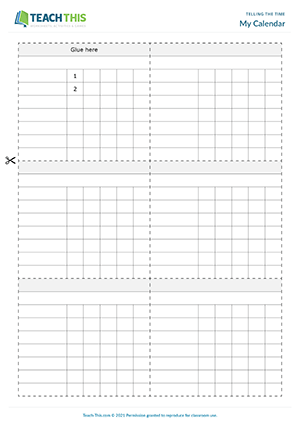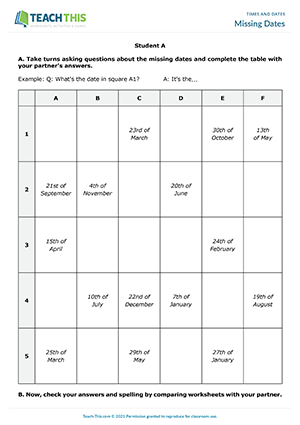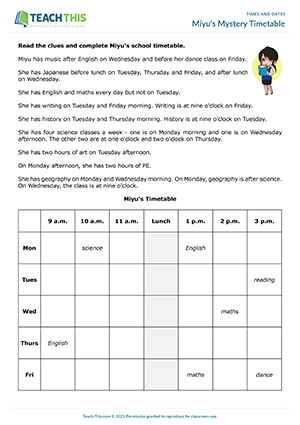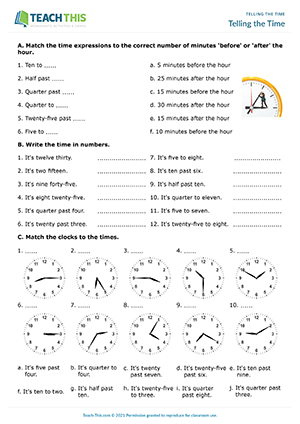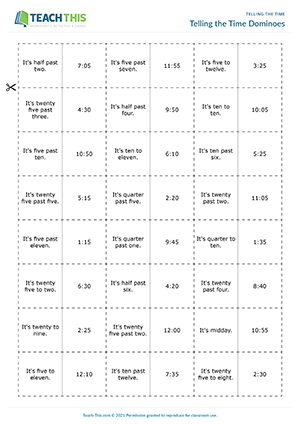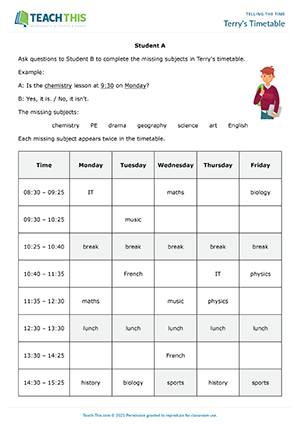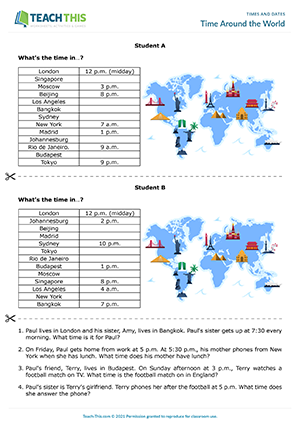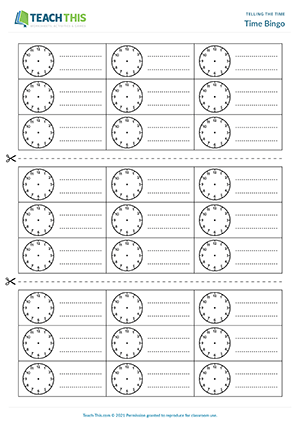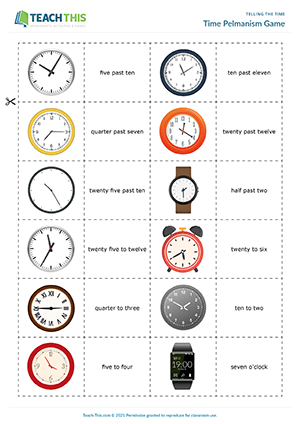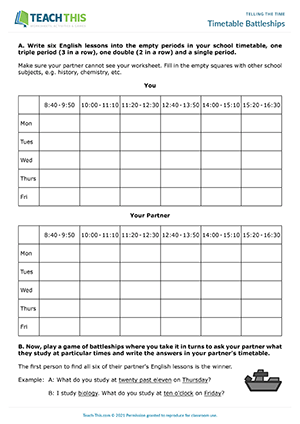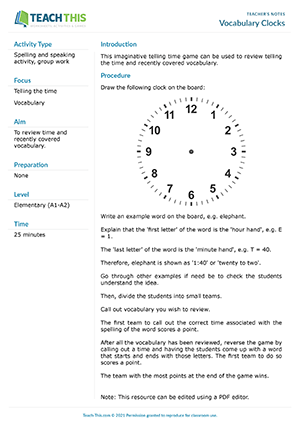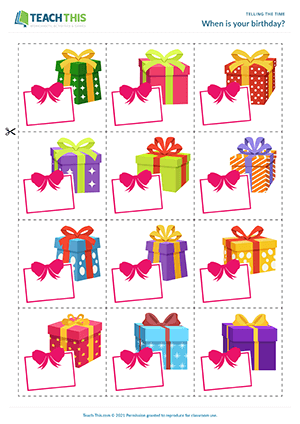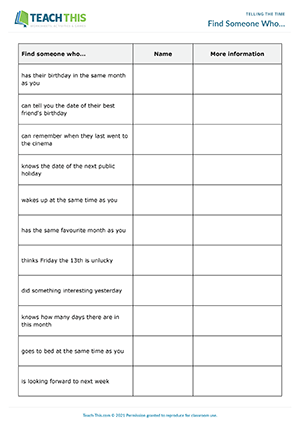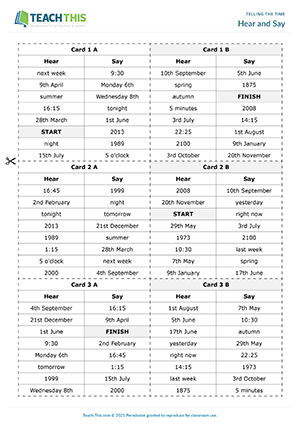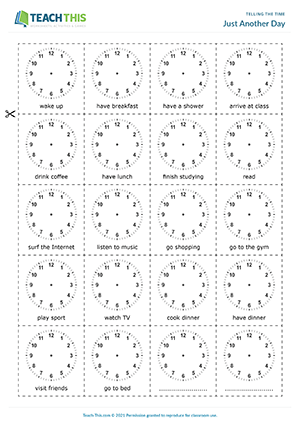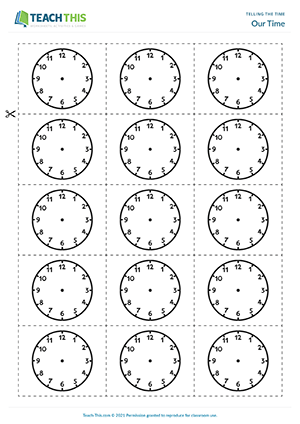Times and Dates ESL Activities, Games and Worksheets
In this creative calendar activity, students make a calendar and fill it with special days or dates such as birthdays, festivals, national holidays, etc. To begin, students learn and practice the rhyme "Thirty days have September". Next, students complete a calendar by writing in months, days of the week and dates. When the calendar is complete, students add colour and pictures as desired, highlighting special days or dates such as family members' birthdays, national holidays, etc. Students then cut out the calendar, stick it together and thread it with a piece of string so it can be hung up.
In this free saying dates activity, students practice ordinal numbers, months and dates. In pairs, students take turns asking questions about missing dates in a chart on their worksheet and complete the chart with their partner's answers. When the students have finished, they check their answers and spelling by comparing worksheets with their partner.
This handy school timetable worksheet is ideal for practicing time, days of the week and school subjects. Students read clues on the worksheet and complete the missing subjects in Miyu's school timetable. Afterwards, draw the timetable on the board and elicit the answers from the class.
In this comprehensive telling the time worksheet, students learn and practice telling the time using numbers and expressions past and to. Students begin by matching time expressions to the number of minutes before or after the hour. Next, students write times in numbers and then match clocks to times. After that, students draw times on blank clock faces. Following that, students write times in words using past and to. In the last exercise, students match times with 24-hour clocks.
This enjoyable telling the time game helps students practice saying the time with past and to by matching written times to times on digital clocks. The first student puts a domino down either before or after the domino on the table, making sure the written time on one domino matches the digital clock on the other domino or vice-versa. The student then reads the time aloud to the group for confirmation. If the times don't match, the student must take back the domino. Play then passes to the next student and so on. The first player to get rid of all their dominoes wins the game.
In this telling the time speaking activity, students practice telling the time, time prepositions and school subjects. In pairs, students take it in turns to ask their partner questions and complete missing subjects in Terry's school timetable. They do this by guessing which subject from the worksheet Terry studies at a particular time, e.g. 'Is the chemistry lesson at 9:30 on Monday?' When both students have finished, they check their answers by comparing timetables.
In this useful time zones speaking activity, students practice asking and answering questions about the time in different cities around the world. The students' task is to find out the time in cities around the world when it is midday in London. In pairs, students take turns asking their partner questions about the missing time for each city on their worksheet, e.g. 'What's the time in Singapore?' Their partner replies with the time shown on their worksheet, e.g. 'It's 8 p.m.' The student then writes the time into the table. Afterwards, in pairs, students answer a set of time zone questions.
In this engaging telling the time game, students play bingo using time. To begin, students draw a different time (o'clock) on each clock face on their bingo card, e.g. one o'clock, five o'clock, etc. In the space next to each clock face, students write: in the morning, in the afternoon, in the evening, midday or midnight. Next, call out times as numbers with a.m. and p.m., e.g. 1 a.m. If students have a matching time on their card, they cross it off. When a student has crossed off all nine times, they shout 'bingo' and read out the nine times using o'clock and the time expression, e.g. one o'clock in the morning. If the times are correct, the student wins the round. If not, the game continues. Practice a different time in each round, e.g. the next round could practice half past and so on.
In these two free telling the time games, students match times to clock picture cards and practice saying the time. In pairs, students take it in turns to turn over one clock picture card and one word card. If a student turns over a matching pair of cards, the student says the time, e.g. 'It's half past six'. The student then keeps the pair of cards and has another turn. The student with the most pairs of cards at the end of the game wins. Afterwards, students test each other on the times using the picture cards. Students take it in turns to pick up a clock picture card, show it to their partner and ask What's the time? Their partner then tells the time on the card. If the answer is correct, the student scores a point. The student with the most points at the end of the game wins.
In this fun telling the time game, students play battleships by trying to find six English lessons in a partner's school timetable. To start, students write six English lessons into the empty timetable on the worksheet. Students fill in the empty squares with other school subjects, e.g. history, chemistry, etc. Students then play a game of battleships where they take it in turns to ask their partner what they study at particular times and write the answers in their partner's timetable on the worksheet. The first person to find all six of their partner's English lessons is the winner.
This creative time game can be used to review telling the time and recently covered vocabulary. Draw a clock on the board. Next to each number, write letters of the alphabet. The first letter of the word is the hour hand and the last letter of the word is the minute hand. Call out a word. The teams then race to call out the correct time. The first team to call out the correct time associated with the spelling of the word scores a point. After all the vocabulary has been reviewed, the game is reversed. Call out a time and the teams come up with a word that starts and ends with those letters. The first team to do this scores a point. The team with the most points at the end of the game wins.
In this intriguing saying dates activity, students practice asking and answering questions about birthdays. Give each student a card that shows a gift-wrapped present and a label. Students write the date of their birthday on the label. Collect in the cards and then redistribute them so each student has someone else's birthday on a card. Students imagine what is under the gift-wrapping of the present (e.g. a box of chocolates) and write the present on the back of the card. The students' task is to find out who their present is for and to give it to them. To do this, students walk around the class asking When is your birthday? until they find the person who has the same birthday as the one shown on their card. When a student finds the owner of the card, they give it to them and explain what the present is, e.g. 'I bought you a box of chocolates. I hope you like them'. Afterwards, there is a class feedback session to find out what present each student received and if the students like their presents.
In this time Find Someone Who activity, students practice asking and answering questions about time. Students begin by going through the items on the worksheet and forming the various yes/ no questions they need to ask in order to do the activity. Students then go around the class, asking each other the yes/no questions for the items on the worksheet, e.g. 'Is your birthday in July?' When a student finds someone who answers 'yes' to a question, the student writes down their name and asks a follow-up question to gain more information, noting down the answer. When everyone has finished, students give feedback to the class on what they found out.
This entertaining saying times game helps students review and practice telling the time, time prepositions and saying days, months, years, dates and other time expressions. The student with 'start' on their card begins by saying the time expression indicated in the 'Say' column next to 'start'. The other students in the group listen carefully and try to find the time expression in the 'Hear' column on their cards. If a student sees a matching time in the 'Hear' column, they say the corresponding time expression in the 'Say' column for the other students to recognise. Students must add in any prepositions of time or articles that are necessary, e.g. the 28th of March, Monday the 6th, in 2013, etc. If they have a time, e.g. 16:45, they say the time as 'quarter to five' rather than just reading the number. Play passes from student to student until they reach the finish. Students then repeat the game with another set of cards.
In this free telling the time speaking activity, students practice saying times and using the present simple to describe a partner's everyday activities. First, students choose cards that show the activities they do on a normal day and indicate when they do each activity by drawing the time on the clock. Next, students exchange cards with a partner and layout their partner's activities in order, according to the times on the clocks. Students then take it in turns to look at their partner's cards and describe their normal day, e.g. 'You wake up at half past six. You have breakfast at seven o'clock, etc.' Afterwards, students find differences in what they do every day, e.g. 'I wake up at seven o’clock, but you wake up at half past seven'. Next, students take their partner's activity cards and work with a new partner. This time, students layout their original partner's cards in the correct order and describe his or her normal day to their new partner using the third-person singular.
In this productive telling the time speaking activity, students practice telling the time and describing a particular time's importance. Each student writes the names of everyone in the class on a piece of paper and is given a clock card. On the clock face, students draw a time that is important to them. Students then go around the classroom asking and telling each other the time on their clock. Every time a student asks another student for their time, they find out why it is important. The student notes down the time next to the name of the student on their paper and the reason for its importance. In pairs, students then put the names of everybody in the class in order, according to who had the earliest to latest time on their clock. Students also write a sentence for each student about what they do at that time, e.g. 'At half past seven, Steve arrives at the bus stop. At quarter past eight, Kim has breakfast, etc.' Afterwards, there is a class feedback session to review the correct order and answers with the class.



